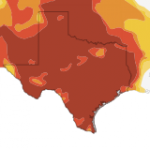Life By the Drop: Rice Farming After the Water is Cut Off
 2011 was not only Texas’ worst single-year drought. By a strange twist of fate, it was also the year the state formed its new long-term water plan. Some planners viewed this as a blessing-in-disguise: as least the drought was raising awareness of water issues.
2011 was not only Texas’ worst single-year drought. By a strange twist of fate, it was also the year the state formed its new long-term water plan. Some planners viewed this as a blessing-in-disguise: as least the drought was raising awareness of water issues.
The planning process forced some hard questions: what role will agriculture play in the future of Texas? Should Texans continue to raise water-intensive crops like corn and rice?
Currently, more than half of the state’s water resources go to agriculture. Much of what’s left of our untapped water supplies exist in rural parts of the state, far from population centers. For cities to have enough water in the future, state planners estimate that agriculture,especially water-intensive agriculture, will have to cut back.
Those cuts were already forced this year in the lower regions of the Colorado River, where rice farmers were not given water stored in the Highland Lakes, to ensure that reservoirs upstream remained adequate for population centers like Austin. In 2011, the lakes neared some of their lowest levels in history as water was sent to rice farmers downstream to flood their fields. They used more than three times as much water as the city of Austin.
The cut-off was an extraordinary measure prompted by the drought. It was the first time in the history of rice farming in southeast Texas that they weren’t given water. But it could serve as a preview of things to come. Now, rice farmers are fighting upstream interests, including the city of Austin and communities along the Highland Lakes, over the area’s regional water plan. At issue: how low do reservoir levels have to go before water to rice farmers is cut off again?
Today we talk to a rice farmer in Wharton County about what the river means to him, and why he believes one of the most water-intensive forms of agriculture should still have a place in drought-stricken Texas.
You can listen to the sound portrait and view a slideshow produced by StateImpact Texas’ Filipa Rodrigues by clicking the video player above.



